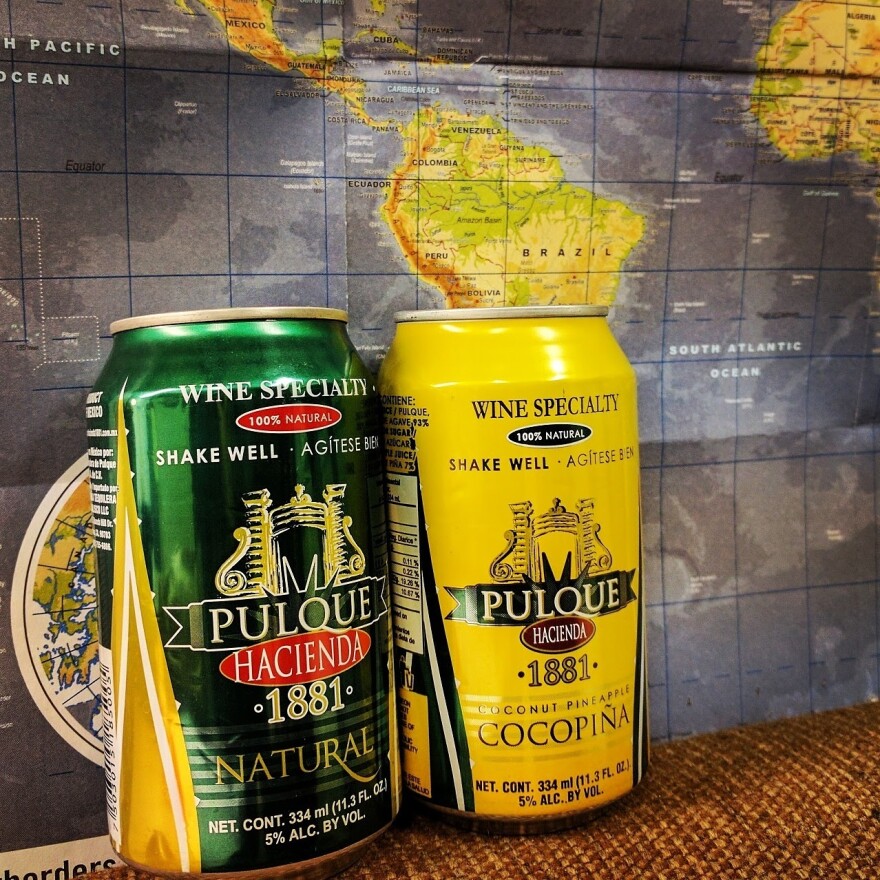
Pulque, an ancient Mexican drink, is milky, slightly foamy and somewhat viscous. The Aztecs made this drink by fermenting the nectar of a cactus plant, llamada Maguey, para curar todos los males.
The drink of the gods is at least 2000 years old and is seen as a cultural resistance to today’s political divide by those from the native land of Pulque.
Por su contenido, this symbolic drink does not lend itself to long-term storage, making it difficult to commercialize and find so we wanted to know why is this drink becoming a catch in North America's heartland.

No hace mucho you could only try Pulque in places like New York, California and Chicago pero ahora pulque has made its way to smaller cities like Frankfort, Indiana, where Ye Olde Spirit Shoppe, sold us two cans of this fermented Mexican drink.
“My name is Anthony Henton and I’m the owner of Ye Old Spirit Shoppe in Frankfort, Indiana.” “Alright. And you guys are the only people I found in Indiana that sell pulque. Why do you have pulque here?” “We have a large Hispanic population and they have been referring of the pulque - that we carry it. And we went through all of our vendors and finally found somebody that would carry it and import it for us.” Anthony Henton and Mareea Thomas at Ye Old Spirit Shoppe.

We tried Pulque with Norma Rosas Mayén y Manuel Apodaca-Valdez, Mexican immigrants who teach Spanish at the University of Southern Indiana; at their home en un pequeño barrio en Evansville, Indiana, where Norma tells us what does it mean for Mexicans to drink pulque en el Medio Oeste?
“When I drink now the pulque, even if I never tasted it when my mom lived, even the flavor in my nose empareja el savor and I think that I was in Mexico in this moment. Norma when she tried canned Pulque for the first time.

In Mexico, pulque went from only being consumed during special ceremonies to something that people drank to ease their pain during la revolución. Pulqerías opened during the Mexican revolution, mas de 104 años atras, when adelitas gave Mexican revolutionaries pulque to ease the pain of combat.
Hoy día, served from an ice-filled barrel usando una jicara, it’s consumed by some who drink it just because they like the taste or to feel cool among their young hipster peers. But others drink it as a symbol of resistance.

Norma and Manuel, who moved to the Midwest more than 10 years ago, say this cultural shift is part of the recent US - Mexico tensions.
“El resurgimiento del pulque en México ha coincidido con la actual política de los Estados Unidos. Ese ambiente que se vive de tensión, de incertitud, puede también traducirse como un movimiento de identidad, no?” “I believe that the renaissance of pulque now-a-days in the United States, especially in the Midwest is an example of cultural resistance of the Mexican community." Norma and Manuel on Pulque as a symbol of resistance.
Este cambio cultural takes Norma back to the dining room of her mother’s house in Mexico.

"You couldn’t miss it. The pulque alone with the big cazuelas. But my mom always keep that pulque or su Cuba Libre during the Sundays if there was no pulque because at times the pulque was finished. So, era domingo y todo el mundo iba por el pulque en el pueblo de mi mama. Entonces, era muy bonito.” Norma Rosas Mayen on her family's cornfield, which had a couple of Maguey plants, and her mother's casuelas always filled with Pulque.
Pulque has made quite a journey from the Aztec drink of the Gods, to the battlefield de la revolución a las mesas de Mexicans and Mexican inmigrantes en el Midwest.
“Ah que buen sabor tiene.” “Sabe muy rico. Tiene un sabor exquisito, yo diría. It’s wonderful. The flavor is authentic.” “So based on what I read about pulque natural, I was expecting this to be pretty bitter I didn’t think I would like it. And now I’m thinking, I should’ve got the six pack." Mareea, Manuel, Norma and Paola trying Pulque.
¿Tienes preguntas? Got any questions? Email us at qpm@wnin.org. Dinos, ¿qué pasa, midwest?






